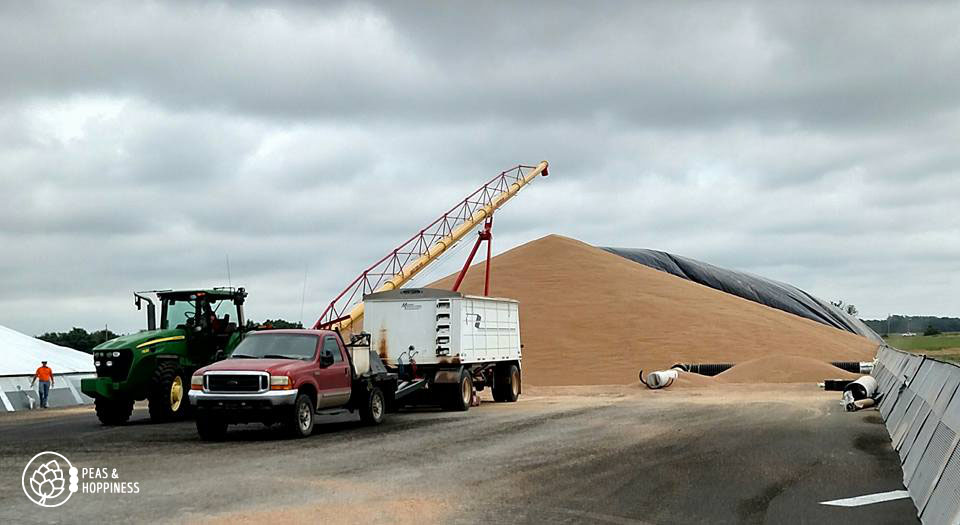Unpredictability is the name of the game when it comes to farming. Weather, pests, breakdowns, and (perhaps most frustrating), the marketplace.
Things have been especially good this year: plenty of rain and sunshine at just the right time. Fortunately (or unfortunately?) it’s been good everywhere. The Former Soviet Union and Europe had record-breaking wheat harvests this year. Thus, surpluses abound.
For those of you who’ve had training in basic economics, you know what happens to price when supply outweighs demand. That’s right – price goes down.
That’s what’s happening right now.

A 20-year history of wheat price, not adjusted for inflation. As you can see, wheat prices today are about the same as they were 20 years ago, despite the increased price of inputs (fertilizer, pesticide, diesel, machinery, land, etc.). This means profits for farmers are razor-thin, so small farms are unable to compete.
During a year that my dad is harvesting some of the highest yields of wheat and corn, his return-on-investment is significantly lower than what it would have been three years ago. In fact, his wheat now earns him almost a third less today than it did in late 2012.
Imagine earning $90,000 for a couple of years in a row. Then, suddenly and without warning, your salary is reduced to $30,000. This reduction is indefinite and may go up or down at a moment’s notice.
That’s the life of a farmer.

A grain elevator, where grain is taken and stored, then loaded into trains and trucks and shipped across the nation.
The Ants and the Grasshopper
If you’ve never heard Aesop’s Fable of the Ants and the Grasshopper, go read this one-page story now.
Farmers are great ants. They work hard, save money, and always plan ahead in case of lean times. Most financial advisers recommend having enough money on hand for at least one or two months in case of a job loss or catastrophe. For farmers, this number changes to several years.
With this downturn in the economy, large, established farms with plenty of capital will tighten their belts, put the vacation and new carpet on the back-burner, and manage to make it through.
Smaller farms, those with less capital, or young farmers who haven’t had time to save enough, may not weather the storm of the volatile marketplace. At the very least, they’ll likely have to supplement their income with work other than farming – taking a second part- or full-time job.

Grain handling facility at Scheufler Farms. During harvest, Dad hauls grain here instead of to the elevator to avoid the long lines, then Dan hauls grain from here to the elevators all winter long.
Reality Check
Several generations ago, everybody came from a farming family. It was a true family business in which everybody played a role; even the kids were let out of school in the summer to help with harvest.
With the industrial revolution, sons (and eventually daughters) chose school and other professions and moved to the city rather than farm. Farming itself became mechanized, requiring less hands-on labor. Equipment pulled by tractors rather than horses turned 10-acre farms into thousand-acre farms, then 10,000-acre farms.
Cycles of bad weather, failing crops, and poor market prices further drove some farmers from the profession. Just as now there is no longer a family-owned five-and-dime on your street, but instead a Wal-Mart down the road, so too were smaller, less efficient farmers driven from the marketplace.
Farming is a business, and it’s a hard one.

Piles of grain underneath white tarps in front of the overflowing grain elevator – compliments of the surplus.
Finding a Solution
This is not the first time that a down-turn in the market caused farms to fail. Programs such as Crop Insurance were set up by the federal government to help mitigate some of the risks of farming.
However, this problem of low-prices-so-subsidize-the-farmers has been going on for decades. I have been mulling over this question for years. Why are we growing crops that nobody wants?
Basic economics would say: if the market is saturated and so prices are low, grow something else.
There is no use for the piles of surplus grain, yet still these crops grow in farms across America. But the solution of growing something else is not as easy as it sounds. Should a farmer grow lentils? He doesn’t have the right equipment. Should he grow quinoa? There’s no place to sell the truckloads of grain (ADM and Cargill don’t buy these). What about tomatoes and zucchini? They are far more labor-intensive and perishable than the crops he is used to growing.
I don’t have the answer to this very complex, very old problem. There are many people trying to find an answer, turning to things such as urban farming or niche markets like organic foods.
I am interested in starting a dialogue. I am interested in your solutions – because they are really our solutions.

More piles of surplus grain – too much to fit in the grain elevators
Finally, after more than a year in the Blog-o-sphere, I share with you the question that plagues my heart and where my passion lies: how do we sustainably grow food that people need for a price that people can afford, that is also fair to the farmers who grow it?
Just a small question for you to ponder over with your friends on this Labor Day weekend. I’m enjoying my day off, unlike the farmers I know – who are all busy in their combines gathering in the first fruits of fall harvest.
With love, from Peas and Hoppiness.